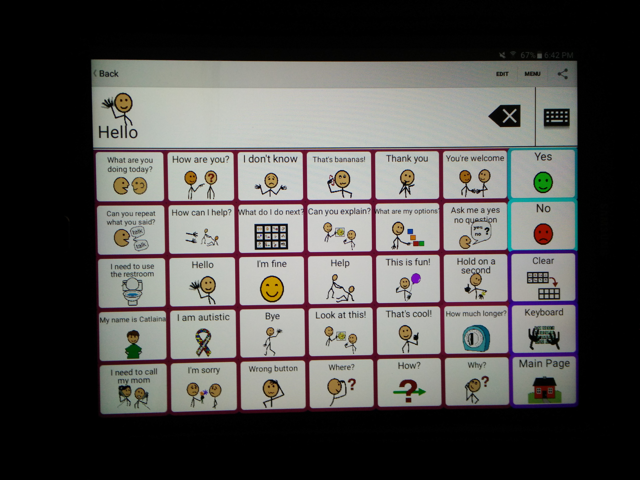As an autistic person, I am very familiar with AAC. I use it, and I am around others who use it too. Because it is AAC awareness month, I thought this was a good opportunity to write about it.
So, first off, what exactly is AAC?
AAC stands for Augmentative and Alternative Communication. AAC is a way of expressing needs without vocalization.
There are many different reasons why someone might communicate with AAC. Some people have trouble hearing, some people may have difficulty controlling their muscles to form words, and some people may have a language/communication disorder, like autism.
AAC acts as a sort of ‘bridge’ of communication for those with special needs, translating pictures into words. There are three general types of AAC. There is ‘no-tech’ AAC, which includes sign language and gestures. This is probably the most recognized form of AAC. There is also ‘low-tech” AAC, which would be something like a picture symbols (PECS) book, pencil and paper, or a letter board. Then there is ‘high-tech’ AAC, which would be an app on a tablet, or a device that is entirely made for communication.
What is a good AAC?
Any AAC that is robust, accessible and used. Dynavox’s Snap+Core First, Speak For Yourself, LAMP, and CoughDrop are some of the most popular grid-based communication software. ‘Core words’ make up about 80% of what we say, like “want’, ‘go’, ‘give’ and ‘you.’ AAC with this language at the foundation is easier to communicate with than a a list of just nouns, and is applicable to many different situations. Though it is less concrete and more difficult to teach, it’s versatility for communication wins in the end.
AAC is good if it is accessible to the person. Eye- gaze, switches and keyguards can make a device accessible to someone who is physically disabled. Symbols with text can help people who have cognitive disabilities or those with autism communicate quicker or without the prerequisite of literacy.
To determine if an aac is good, look at what someone can really say with it. A robust system can communicate wants and opinions, express emotions, tell jokes or a story, answer a question and carry a conversation.
For more information for teachers using AAC in their classroom see: Setting Up Successful AAC Use.
For more information for parents who want to use AAC for their children see: Augmentative and Alternative Communication in the Early Childhood Years

